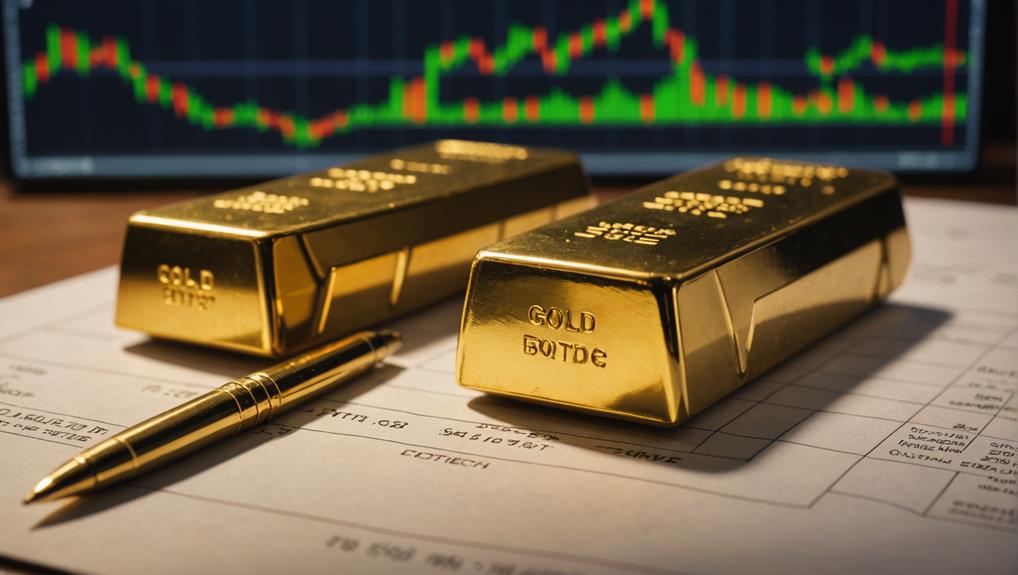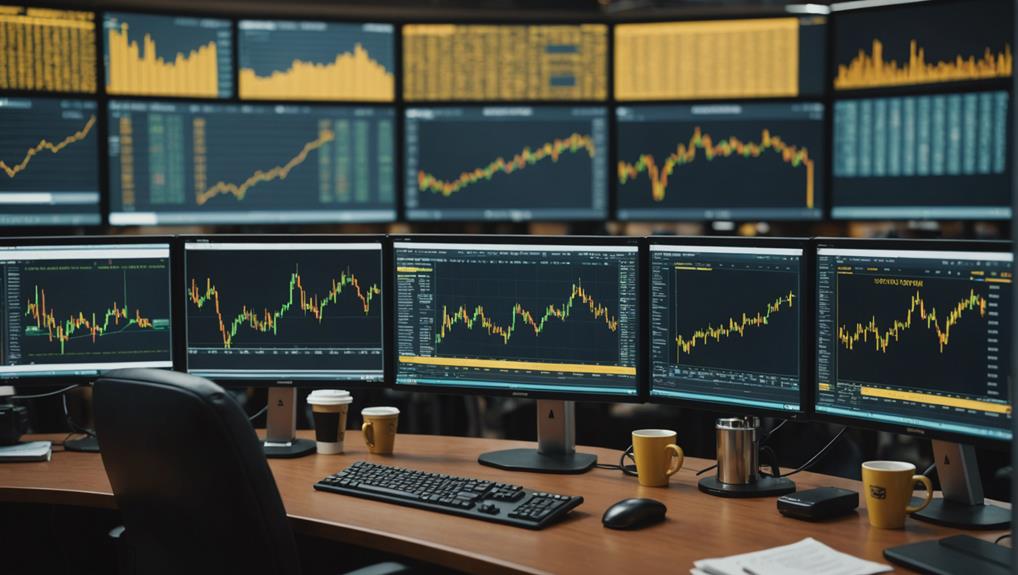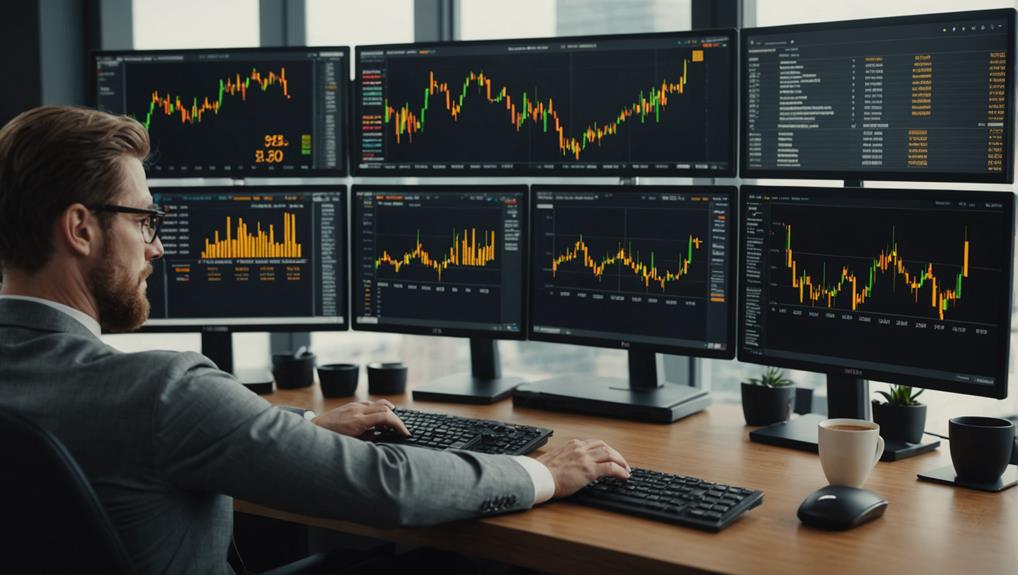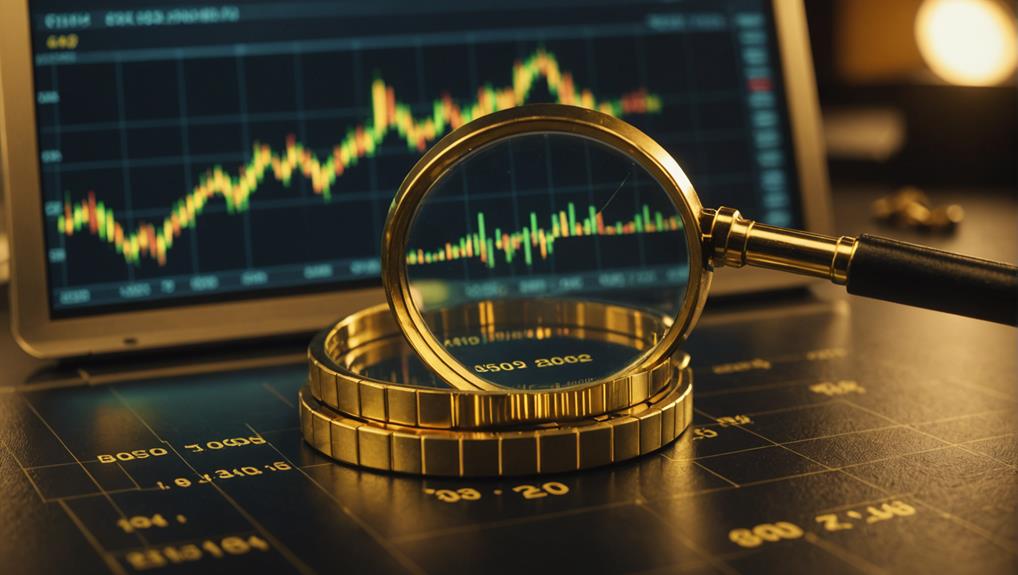Investing in gold futures offers a unique opportunity for investors, whether seasoned or beginners, to capitalize on gold price movements without owning physical gold. This guide aims to demystify the intricacies of gold futures contracts, covering everything from how they are structured to the mechanics of trading on platforms like the COMEX.
Understanding concepts like leverage, margin requirements, and potential risks is crucial for effectively managing investment portfolios. The appeal of gold futures lies in their high liquidity and diversification benefits, making them an enticing option for many.
But how does one get started in this investment journey, and what pitfalls should one avoid?
Key Insights
- Gold futures allow investors to speculate on gold prices without owning physical gold, using leverage to control large positions.
- High leverage in gold futures magnifies both potential profits and losses, requiring diligent risk management.
- Gold futures contracts represent 100 troy ounces of gold, traded on exchanges like COMEX.
- Market liquidity in gold futures ensures easy entry and exit from trades with transparent pricing and low transaction costs.
- Diversifying with gold futures offers portfolio exposure to gold prices, mitigating risks without the need for physical gold storage.
Basics of Gold Futures Contracts

Gold futures contracts involve agreeing to buy or sell a set amount of gold at a specified price on a future date. These standardized contracts, traded on exchanges, provide a way for investors to speculate on gold price movements without owning physical gold.
Leverage is a key aspect of trading gold futures, enabling traders to control a larger gold amount with a smaller initial investment. Understanding margin requirements – the necessary funds to initiate and maintain a position – is crucial for managing risk and potentially profiting from gold market price fluctuations.
How Gold Futures Trading Works
To engage effectively in gold futures trading, it is essential to grasp the operational mechanisms of buying and selling these contracts on exchanges like the COMEX. Gold futures contracts entail committing to purchase or sell a standardized quantity of gold at a predetermined price on a future date.
These contracts provide leverage, enabling investors to control significant amounts of gold with a relatively modest initial investment, referred to as margin requirements. Each futures contract comes with specific specifications outlining the gold quantity, delivery date, and other crucial terms.
Advantages of Investing in Gold Futures

Investing in gold futures offers several benefits, including the potential for high leverage, which allows investors to control large positions with relatively small capital.
The market liquidity of gold futures ensures that traders can enter and exit positions with ease, making it a flexible investment option.
Gold futures also serve as an effective tool for portfolio variation, helping to mitigate risks associated with inflation and market uncertainties.
High Leverage Potential
Gold futures offer investors the advantage of high leverage potential, enabling them to control significant market positions with minimal capital outlay. Platforms like COMEX (Commodity Exchange, Inc.) and NYMEX (New York Mercantile Exchange) facilitate this leverage, allowing investors to speculate on gold price movements.
This high leverage amplifies both potential profits and losses, making gold futures a high-risk, high-reward investment avenue. Through gold futures contracts, investors can benefit from price fluctuations without the need to own physical gold.
While leveraging can be lucrative, it necessitates diligent risk management and a profound comprehension of market dynamics to mitigate substantial losses. Therefore, strategic leveraging in gold futures can yield profitable outcomes when approached thoughtfully.
Market Liquidity Benefits
Gold futures offer a myriad of benefits, with market liquidity standing out as a key advantage. This liquidity empowers investors to efficiently enter and exit positions, thanks to robust trading volumes. Tighter bid-ask spreads reduce transaction costs, enhancing the trading experience.
Real-time pricing information is readily available due to the high trading volume, ensuring price transparency. Furthermore, the market depth in gold futures allows for significant trading volumes without unduly impacting prices, facilitating efficient price discovery.
The global nature of gold futures markets means continuous trading opportunities across different time zones, catering to various trading preferences. Ultimately, the liquidity benefits of gold futures create a dynamic and accessible investment environment, bolstering its appeal to investors.
Portfolio Diversification Tool
Gold futures are a valuable addition to any investment portfolio, offering a strategic asset for diversification. Integrating gold futures can provide exposure to gold prices, serving as a hedge against inflation and economic uncertainties.
Unlike physical gold ownership, futures contracts offer liquidity and flexibility, eliminating the need for storage. With the leverage inherent in futures contracts, investors can control larger positions with a smaller capital outlay, potentially enhancing returns. This ability to leverage positions and hedge risks makes gold futures an appealing option for portfolio diversification.
Risks of Gold Futures Investing
Investing in gold futures carries substantial risks due to market volatility, which can cause rapid price fluctuations. The high leverage involved can amplify potential losses as swiftly as it can magnify gains, making it essential for investors to manage their risk carefully.
Moreover, understanding the complexities of contract expiry dates and margin requirements is vital to avoid unexpected financial pitfalls.
Market Volatility Impact
Gold futures trading demands a deep understanding of its volatile nature, influenced by economic shifts and geopolitical tensions. This volatility can trigger abrupt price changes, leading to substantial profits or losses.
Economic indicators like interest rate adjustments, inflation figures, and employment data frequently act as catalysts for rapid gold price fluctuations. Similarly, geopolitical uncertainties, such as political unrest, military conflicts, and trade disputes, fuel market speculation and unpredictability, magnifying investment risks.
Investors must anticipate sudden market movements and acknowledge the significant impact of these external factors on their trading positions. Skillfully managing these risks is crucial for successfully navigating the dynamic gold futures market.
Leverage-Driven Potential Losses
Gold futures are heavily influenced by market volatility, making the use of leverage a double-edged sword. By allowing traders to control a larger contract value with a minimal margin deposit, leverage magnifies both potential gains and significant financial risks.
The amplification effect of leverage means that losses have the potential to exceed the initial margin deposit, underscoring the importance of effective risk management. Implementing tools like stop-loss orders can help mitigate these risks by automatically selling positions when prices hit a predetermined level, thus limiting downside exposure.
Understanding the leverage-driven risks inherent in gold futures is essential for making informed trading decisions and safeguarding capital from sudden and severe market fluctuations.
Contract Expiry Challenges
Managing contract expiry is crucial for traders in the gold futures market due to the inherent risks involved. Gold contracts have expiration dates, and failing to handle them properly can lead to significant challenges.
If a trader doesn't close or roll over their position before the delivery date, they may be required to accept physical delivery of gold. However, this option is often impractical due to storage constraints and associated costs.
To avoid such situations, traders must closely monitor market conditions and price movements to strategically time their exits, either maximizing profits or minimizing losses. Employing rollover strategies by transitioning positions to the next contract month is essential for avoiding physical delivery while still maintaining market exposure.
Understanding and effectively managing these aspects are critical for mitigating risks associated with gold futures trading.
Steps to Start Investing

To embark on your investment journey, it's crucial to start with a well-thought-out strategy and a solid grasp of different asset classes, including the intricacies of gold futures. Begin by conducting thorough research on commodity brokers to identify one that suits your requirements and offers gold futures trading. Understanding the concepts of leverage and risk management is paramount, given the high volatility associated with gold futures. Consider initiating your trading activities with micro contracts as a way to mitigate risks and accumulate valuable experience in the field. Develop a comprehensive trading plan that outlines clear entry and exit strategies. Compare the offerings of various brokerage firms to pinpoint the one that best aligns with your trading preferences and financial objectives.
| Step | Description | Importance |
|---|---|---|
| Research Brokers | Assess and compare commodity brokers' services and fees | Find an optimal trading partner |
| Understand Leverage | Acquire knowledge on leverage and its implications | Crucial for effective risk management |
| Develop a Plan | Formulate a detailed trading plan with precise strategies | Fundamental for achieving success |
Key Specifications of Contracts
To grasp the intricacies of gold futures trading, one must first be well-versed in the fundamental specifications of the contracts. These specifications serve as the standardized framework dictating the terms and conditions of each trade.
Gold futures contracts typically represent 100 troy ounces of gold and are actively traded on established exchanges such as the Chicago Mercantile Exchange (CME). Each contract is tied to specific expiration months, with prices quoted in dollars per troy ounce.
A pivotal component to consider is the strike price, serving as the prearranged price point at which the contract is executed. Traders navigating options on gold futures must also factor in the option premium, representing the cost associated with acquiring the option.
It is essential to discern whether they are engaging in call options, granting them the right to purchase the gold futures contract at the strike price.
Strategies for Gold Futures

To effectively engage with gold futures, traders must blend technical analysis, risk management, and a keen awareness of market fundamentals.
Technical analysis serves as a crucial tool for pinpointing optimal entry and exit points through the study of price charts and market trends.
Additionally, fundamental analysis plays a vital role in grasping how geopolitical events and economic indicators influence gold prices.
Mitigating risk is paramount, and employing robust risk management techniques such as setting stop-loss orders safeguards against substantial losses from adverse price fluctuations.
Diversifying exposure can be achieved through spread trading strategies like calendar spreads and inter-commodity spreads, offering a means to manage risk effectively.
Remaining abreast of market trends and gold-related news equips traders to make informed decisions, ultimately enhancing the potential for profitable ventures in gold futures.
Common Mistakes to Avoid
When investing in gold futures, it is important to be aware of common pitfalls that can undermine your success.
Overleveraging your position can expose you to significant losses due to the volatile nature of gold prices.
Ignoring market trends and poor risk management, such as neglecting stop-loss orders, can further jeopardize your investments.
Overleveraging Your Position
Overleveraging in gold futures is a prevalent error that can greatly magnify both potential profits and devastating losses. This risky practice involves utilizing excessive leverage, which can result in margin calls and the forced closure of positions if the market moves unfavorably. It is crucial to comprehend the associated risks and establish appropriate leverage ratios to prevent overexposure. By implementing prudent risk management strategies, you can safeguard your investment and preserve the stability of your trading account.
Key Risk Factors | Potential Consequences | Risk Mitigation Measures
———————–|————————|—————————
Excessive Leverage | Increased Losses | Set and adhere to suitable leverage ratios
Market Volatility | Margin Calls | Monitor positions closely and react proactively
Insufficient Capital | Account Liquidation | Maintain adequate reserves to cover potential losses
Inadequate Risk Management | Swift Account Depletion | Implement effective risk mitigation strategies
Ignoring Market Trends
Neglecting market trends can severely impact the profitability of gold futures trading. Failing to analyze and respond to these trends often results in missed opportunities for profitable trades and can lead to entering positions at unfavorable times.
Successful trading hinges on the careful examination of price movements and volume, essential indicators of market sentiment and future price actions. Disregarding these crucial factors can result in avoidable losses and an inability to adjust to shifting market conditions.
Through trend analysis, which involves studying historical price movements and trading volume, traders can make informed decisions and adapt their strategies accordingly. Continuously monitoring market trends is essential for maximizing profits and minimizing risks in gold futures trading.
Poor Risk Management
To navigate the volatile gold futures market successfully, it is imperative to prioritize effective risk management strategies. Beginners often overlook the importance of having a solid risk management plan in place, exposing themselves to potential significant losses.
Implementing stop-loss orders and carefully managing position sizes are essential measures to mitigate risks. Market volatility and the impact of leverage should not be underestimated, as they can exacerbate losses if not taken into account.
Staying vigilant and informed about market trends is crucial to making prudent decisions and safeguarding capital in gold futures trading. By adopting a proactive approach to risk management, newcomers can enhance their chances of achieving consistent gains and avoiding costly mistakes in this complex market.
Choosing a Broker

Choosing a broker for gold futures trading requires prioritizing a user-friendly platform like Thinkorswim, tailored for novice traders. Look for brokers offering competitive commission rates and efficient order execution for cost-effectiveness and timely trades.
Assess their margin requirements, which determine the capital needed to trade gold futures. Opt for brokers providing extensive educational resources and tools for beginners to grasp the complexities of gold futures trading.
Additionally, consider brokers with strong customer support and a solid reputation for a reliable and supportive trading experience. By focusing on these factors, you can make informed decisions and navigate your trading venture strategically.
Factors Influencing Prices
Gold futures prices are impacted by a variety of factors, including supply and demand dynamics, economic indicators, and geopolitical events. Supply and demand play a crucial role, with limited supply and high demand leading to price increases.
Economic indicators such as GDP growth, unemployment rates, and consumer sentiment also influence prices significantly. For instance, weaker economic indicators can drive investors towards gold as a safe haven, boosting demand and prices.
Geopolitical events, such as political instability or trade tensions, create market uncertainty, further affecting gold futures.
Additionally, central bank policies and inflation rates are key factors, as lower interest rates and higher inflation typically result in higher gold futures prices.
Conclusion
Gold futures offer a strategic and leveraged approach to investing in gold without the need to own the physical asset. To navigate this investment avenue effectively, it is essential to grasp margin requirements, contract specifics, and trading mechanics for sound risk management.
The allure of high leverage potential, market liquidity, and portfolio diversification makes gold futures an attractive option for investors. However, it is crucial to be vigilant about the inherent risks involved. By adopting a systematic strategy, steering clear of common pitfalls, investors can capitalize on the opportunities that gold futures trading presents.
Contact us for more information:
The Gold Information Network
11900 Biscayne Blvd, Ste 127B, Miami, FL 33181
(305) 449-9094
https://goldinfo.net







